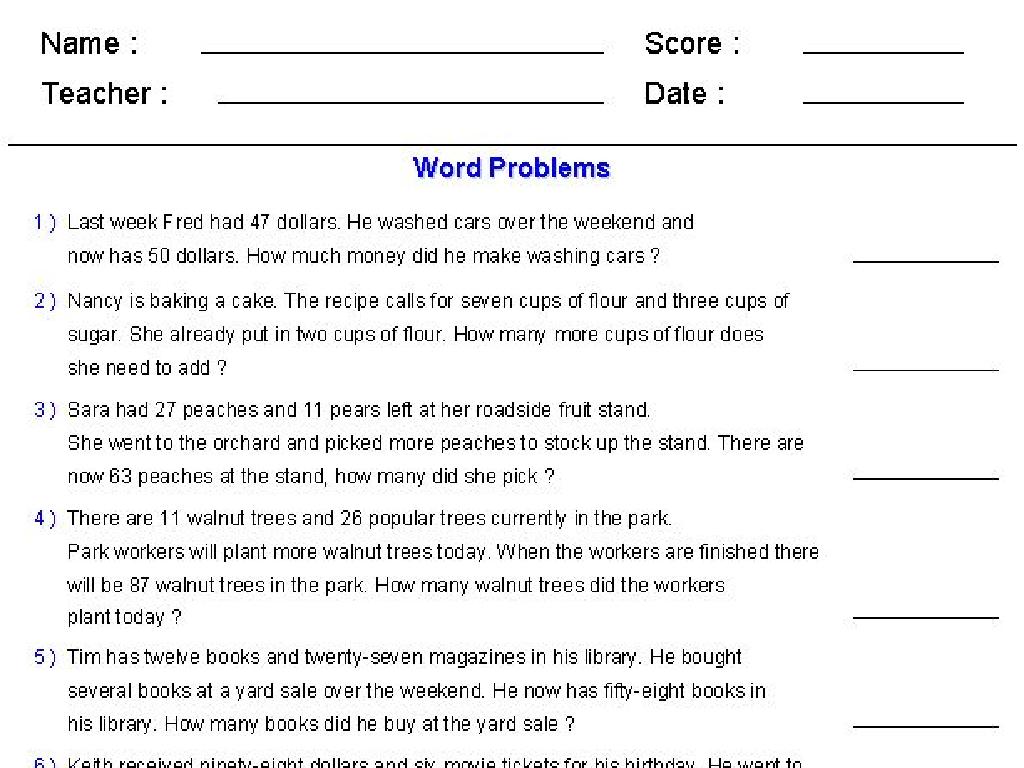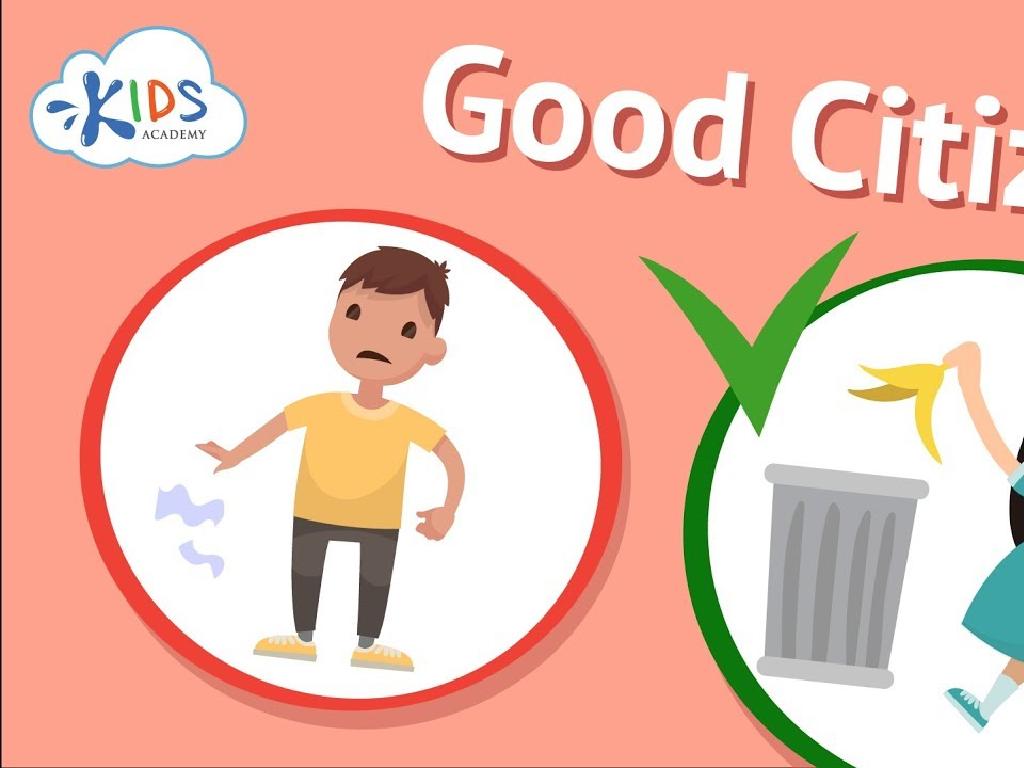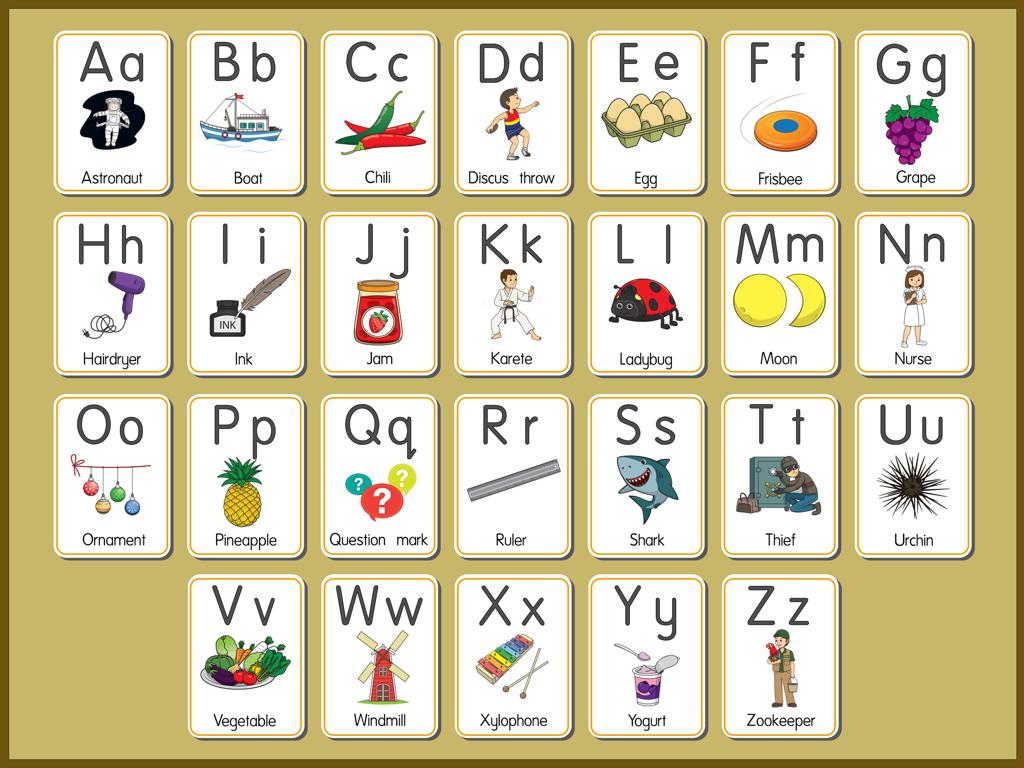Different
Subject: Math
Grade: Pre-k
Topic: Classify
Summary: Introduce young learners to the concept of "different" with this engaging Pre-K math lesson focused on classification. Through colorful visuals, hands-on sorting activities, shape tracing, and size comparisons, children explore how objects differ in color, shape, and size. Interactive games like "Spot the Difference" and creative assignments reinforce observation and comparison skills. This lesson boosts early math understanding while building confidence through fun, personalized learning experiences.
Please LOG IN to download the presentation. Access is available to registered users only.
View More Content
Exploring ‘Different’ in Math
– Greet our young math explorers
– Today’s special math concept
– Understanding ‘Different’
– ‘Different’ means not the same as others
– Fun activities to spot differences
– We’ll play games to find things that are not the same
|
Welcome the students warmly to spark their interest in math. Today’s lesson is about the concept of ‘Different.’ Explain that ‘Different’ means something that is not the same as other things. Use simple, relatable examples like different colors of apples or different shapes of blocks. Engage the children with hands-on activities where they can physically group objects based on their differences, such as sorting by color, size, or shape. This will help them understand the concept in a fun and interactive way. Encourage participation and praise their efforts to build confidence.
Learning About ‘Different’
– ‘Different’ means not the same
– Things can differ in many ways
– Size, shape, color are some aspects
– Let’s explore examples
– For example, a small red ball and a big blue ball
– Finding differences together
|
This slide introduces the concept of ‘different’ to Pre-K students. Start by explaining that ‘different’ means something is not the same as something else. Use tangible examples like toys that vary in size, shape, and color to illustrate the point. Encourage the children to participate by picking out objects from their surroundings and discussing how they are different from each other. This interactive approach will help them understand the concept of ‘different’ in a fun and engaging way. The goal is to make them observe and think about the diversity in the objects around them.
Same vs. Different
– ‘Same’ means looking exactly alike
– ‘Different’ means not looking alike
– Spotting ‘same’ and ‘different’
– Can you find objects that are the same or different?
– Practice with examples
– Let’s look at shapes and colors to decide!
|
This slide introduces the concept of ‘same’ and ‘different’ to Pre-K students as part of learning to classify objects. Begin by explaining that when objects look exactly the same, they are called ‘same.’ When they look different in any way, they are called ‘different.’ Use visual aids like pictures or classroom objects to illustrate this point. Encourage the students to observe and spot similarities and differences among objects. Provide examples using common items, such as two red apples (same) versus an apple and a banana (different). Use shapes and colors as the primary attributes for comparison, as these are easily recognizable by Pre-K students. During the class, engage the students in a fun activity where they group objects based on these attributes.
Finding Differences Between Objects
– Observing object differences
– Look at objects and discuss what makes them unique.
– Sorting by color, shape, and size
– We can group objects based on their color, their shape, and how big or small they are.
– Sorting clarifies differences
– When we sort objects, it’s easier to see how they are not the same.
|
This slide is aimed at helping Pre-K students understand the concept of classification by finding differences. Start by showing them a variety of objects and asking them to point out how they differ from one another. Encourage them to think about the color, shape, and size of each object. Sorting activities are a great way to reinforce these concepts, as they allow children to group objects and visually see the differences. This hands-on approach helps young learners to grasp the idea of classification in a tangible and engaging way. For the activity, provide a set of objects that can be easily sorted into categories and let the children practice sorting them on their own or in small groups.
Colors That Are Different
– Colors can be different
– Red is not the same as blue
– Sing the rainbow song
– Learn about colors through a song
– Point to colors in the room
– Find and point to red, blue, yellow objects
– Red, blue, and yellow
|
This slide is designed to teach Pre-K students about the concept of differences using colors as an example. Start by explaining that colors, like objects, can be different from one another. Use the rainbow song to introduce the concept of different colors in a fun and engaging way. Encourage the children to actively participate by pointing to objects in the classroom that match the colors mentioned in the song. This activity helps to reinforce their understanding of the concept of ‘different’ by providing a hands-on learning experience. It also aids in color recognition and following instructions. Make sure to praise their efforts and correct gently if they make mistakes.
Shapes That Are Different
– Circles are round
– Squares have corners
– Trace shapes with fingers
– Use your finger to follow the edges of each shape
– Share your favorite shape
– Think about the shape you like most and tell us why
|
This slide introduces the concept of different shapes to Pre-K students, emphasizing the distinction between circles and squares. Encourage the students to use their fingers to trace various shapes, which helps in tactile learning and reinforces shape recognition. Ask the students to identify their favorite shape and articulate a reason for their preference, fostering a personal connection to the lesson. Provide a variety of shapes for the students to explore and trace. As an activity, you can have shape cutouts for them to trace with their fingers or draw on paper. This interactive approach will help them remember the shapes and their characteristics.
Sizes That Are Different
– Big and small differences
– Some things are big like a bear, some are small like a mouse
– Compare sizes with toys
– Which toy is bigger? A teddy bear or a toy car?
– Play ‘Big and Small’ game
– Find and show toys that are big and those that are small
|
This slide introduces the concept of size differences to Pre-K students. Start by explaining that objects can vary in size; some things are big, and some are small. Use relatable examples like animals or everyday items. Then, engage the children by comparing the sizes of toys, which will help them visually understand the concept of big and small. The ‘Big and Small’ game is an interactive activity where students can choose toys and classify them based on their size. This hands-on approach reinforces their learning and makes the concept of size more concrete. Encourage the children to use descriptive words and ask them questions about the sizes of objects they see every day.
Class Activity: Spot the Difference
– Let’s play ‘Spot the Difference’
– Look at pictures with a buddy
– Find as many differences as you can
– Use your observation skills to notice what’s not the same
– Have fun comparing your findings!
– Share what’s different with your friend and the class
|
This interactive class activity is designed to help Pre-K students understand the concept of ‘Different’ by engaging them in a fun ‘Spot the Difference’ game. Provide pairs of images that are nearly identical with slight variations. Encourage the children to work in pairs to foster teamwork and communication skills. As they find differences, they’ll develop their observational abilities and learn to articulate what makes objects distinct from one another. Offer guidance and support as needed, and ensure each pair has a chance to share their findings with the class. This activity can be tailored with different images to suit various learning levels and can be made more challenging by increasing the number of differences to find.
Celebrating Our Differences
– Great job exploring differences
– ‘Different’ means not the same
– Things that are not identical or alike
– Each of you is unique
– Like snowflakes, no two are alike
– Embrace being special
– Your uniqueness is your superpower
|
This slide is meant to wrap up the lesson on ‘Different’ by praising the students for their efforts in identifying differences. Reinforce the concept that ‘different’ means things are not the same, and this is what makes everything interesting and special. Highlight the importance of individuality by reminding them that just like the examples they found today, they too are unique and that’s what makes them special. Encourage them to appreciate and celebrate the differences in themselves and others. This positive reinforcement helps build self-esteem and promotes a healthy classroom environment where diversity is celebrated.
Goodbye and Practice Time!
– Time to say goodbye for now
– Homework: Draw different things
– Find objects that aren’t the same
– Share your drawings next class
– We’ll look at everyone’s pictures
– Keep having fun with differences!
|
As we wrap up today’s class, remind the children that learning about differences continues at home. Encourage them to use their creativity to draw objects that are different from each other, such as a big tree and a small flower, or a round ball and a square box. This activity will help reinforce the concept of ‘different’ in a fun and engaging way. Next class, we’ll have a show and tell to share our artwork, fostering a sense of community and excitement for learning. Remember to praise their efforts and creativity, and make sure they understand the homework is about enjoying the process of discovery and classification.





